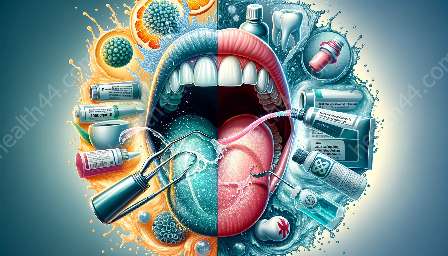Chlorhexidine mouthwash is a widely used oral care product known for its effective antimicrobial properties. This topic cluster aims to provide an in-depth exploration of the pharmacological and pharmaceutical aspects of chlorhexidine mouthwash, including its mechanism of action, therapeutic uses, formulation, and considerations for safe use. Additionally, we'll delve into its role in mouthwash and rinses and discuss its impact on oral health. Let's delve into the science behind this popular mouthwash and uncover its potential benefits and limitations.
The Pharmacological Basis of Chlorhexidine Mouthwash
One of the key aspects of chlorhexidine mouthwash is its pharmacological properties. Chlorhexidine is a broad-spectrum antimicrobial agent that is effective against a wide range of bacteria, fungi, and viruses. Its mechanism of action involves disrupting the cell membrane integrity of microorganisms, leading to their destruction.
Furthermore, chlorhexidine exhibits both bactericidal and bacteriostatic effects, making it a versatile agent for controlling oral infections and preventing the formation of dental plaque. Its substantivity, or the ability to adhere to oral surfaces and exert prolonged antimicrobial activity, enhances its effectiveness in combating oral pathogens.
Therapeutic Uses of Chlorhexidine Mouthwash
Chlorhexidine mouthwash is commonly recommended for various oral health conditions, such as gingivitis, periodontitis, and post-operative oral care. Its ability to reduce plaque accumulation and inhibit the growth of pathogenic microorganisms makes it a valuable adjunct to daily oral hygiene practices. Moreover, chlorhexidine mouthwash is often prescribed for individuals with compromised immune systems to minimize the risk of oral infections.
Beyond its role in treating oral diseases, chlorhexidine mouthwash is also utilized in pre-procedural and post-operative care in dental and oral surgery settings. Its antimicrobial properties help reduce the microbial load in the oral cavity, contributing to the prevention of post-operative complications.
Formulation and Pharmaceutical Considerations
Chlorhexidine mouthwash is available in different formulations, including alcohol-based and alcohol-free solutions. The choice of formulation is influenced by various factors, such as patient preference, oral health conditions, and potential contraindications. Additionally, pharmacokinetic considerations, such as absorption, distribution, metabolism, and excretion of chlorhexidine, play a role in determining its formulation and dosage.
The stability and compatibility of chlorhexidine with other oral care products and medications are essential aspects of its pharmaceutical profile. Healthcare providers and pharmacists must be aware of any potential drug interactions or contraindications when recommending or dispensing chlorhexidine mouthwash to patients.
Role in Mouthwash and Rinses
Chlorhexidine mouthwash is a significant component of mouthwash and rinses designed for oral care and hygiene. Its inclusion in oral rinse formulations aims to enhance their antimicrobial efficacy and contribute to the overall maintenance of oral health. The combination of chlorhexidine with other active ingredients in mouthwash and rinses may offer synergistic benefits, providing comprehensive protection against oral pathogens and promoting oral hygiene.
Impact on Oral Health
When discussing the pharmacology and pharmaceutical aspects of chlorhexidine mouthwash, it's crucial to consider its overall impact on oral health. While chlorhexidine exhibits potent antimicrobial effects and is effective in controlling oral infections, its prolonged use may lead to certain adverse effects, such as tooth staining and altered taste perception.
Furthermore, the appropriate and judicious use of chlorhexidine mouthwash is essential to maximize its benefits while minimizing the risk of adverse reactions. Patient education regarding the correct use and duration of chlorhexidine mouthwash is paramount to ensure its safe and effective application in oral care regimens.
Conclusion
Chlorhexidine mouthwash plays a vital role in oral care, offering a potent antimicrobial solution for addressing various oral health concerns. By understanding its pharmacological and pharmaceutical aspects, healthcare professionals and individuals can make informed decisions regarding its use and integrate it into comprehensive oral hygiene routines. This topic cluster has provided a comprehensive overview of the science behind chlorhexidine mouthwash, delving into its pharmacological basis, therapeutic uses, formulation considerations, and impact on oral health. With this knowledge, individuals can maximize the benefits of chlorhexidine mouthwash while ensuring its safe and effective utilization in maintaining optimal oral hygiene.









